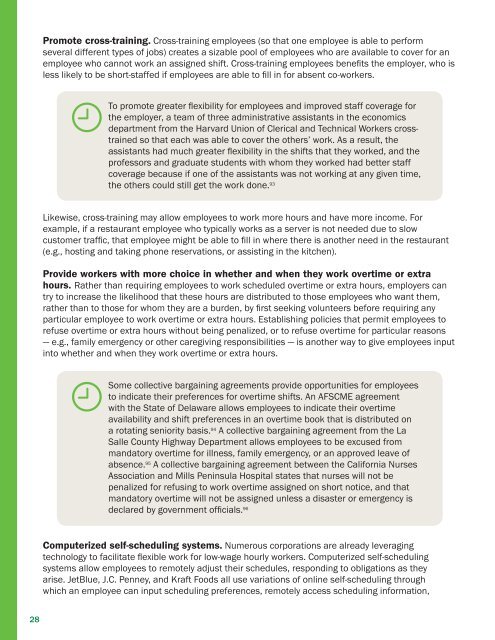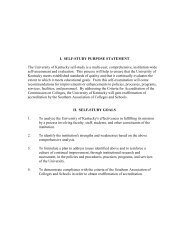Flexible Workplace Solutions for Low-Wage Hourly Workers
Flexible Workplace Solutions for Low-Wage Hourly Workers
Flexible Workplace Solutions for Low-Wage Hourly Workers
Create successful ePaper yourself
Turn your PDF publications into a flip-book with our unique Google optimized e-Paper software.
Promote cross-training. Cross-training employees (so that one employee is able to per<strong>for</strong>m<br />
several different types of jobs) creates a sizable pool of employees who are available to cover <strong>for</strong> an<br />
employee who cannot work an assigned shift. Cross-training employees benefi ts the employer, who is<br />
less likely to be short-staffed if employees are able to fi ll in <strong>for</strong> absent co-workers.<br />
To promote greater fl exibility <strong>for</strong> employees and improved staff coverage <strong>for</strong><br />
the employer, a team of three administrative assistants in the economics<br />
department from the Harvard Union of Clerical and Technical <strong>Workers</strong> crosstrained<br />
so that each was able to cover the others’ work. As a result, the<br />
assistants had much greater fl exibility in the shifts that they worked, and the<br />
professors and graduate students with whom they worked had better staff<br />
coverage because if one of the assistants was not working at any given time,<br />
the others could still get the work done. 93<br />
Likewise, cross-training may allow employees to work more hours and have more income. For<br />
example, if a restaurant employee who typically works as a server is not needed due to slow<br />
customer traffi c, that employee might be able to fi ll in where there is another need in the restaurant<br />
(e.g., hosting and taking phone reservations, or assisting in the kitchen).<br />
Provide workers with more choice in whether and when they work overtime or extra<br />
hours. Rather than requiring employees to work scheduled overtime or extra hours, employers can<br />
try to increase the likelihood that these hours are distributed to those employees who want them,<br />
rather than to those <strong>for</strong> whom they are a burden, by fi rst seeking volunteers be<strong>for</strong>e requiring any<br />
particular employee to work overtime or extra hours. Establishing policies that permit employees to<br />
refuse overtime or extra hours without being penalized, or to refuse overtime <strong>for</strong> particular reasons<br />
— e.g., family emergency or other caregiving responsibilities — is another way to give employees input<br />
into whether and when they work overtime or extra hours.<br />
Some collective bargaining agreements provide opportunities <strong>for</strong> employees<br />
to indicate their preferences <strong>for</strong> overtime shifts. An AFSCME agreement<br />
with the State of Delaware allows employees to indicate their overtime<br />
availability and shift preferences in an overtime book that is distributed on<br />
a rotating seniority basis. 94 A collective bargaining agreement from the La<br />
Salle County Highway Department allows employees to be excused from<br />
mandatory overtime <strong>for</strong> illness, family emergency, or an approved leave of<br />
absence. 95 A collective bargaining agreement between the Cali<strong>for</strong>nia Nurses<br />
Association and Mills Peninsula Hospital states that nurses will not be<br />
penalized <strong>for</strong> refusing to work overtime assigned on short notice, and that<br />
mandatory overtime will not be assigned unless a disaster or emergency is<br />
declared by government offi cials. 96<br />
Computerized self-scheduling systems. Numerous corporations are already leveraging<br />
technology to facilitate fl exible work <strong>for</strong> low-wage hourly workers. Computerized self-scheduling<br />
systems allow employees to remotely adjust their schedules, responding to obligations as they<br />
arise. JetBlue, J.C. Penney, and Kraft Foods all use variations of online self-scheduling through<br />
which an employee can input scheduling preferences, remotely access scheduling in<strong>for</strong>mation,<br />
28

















